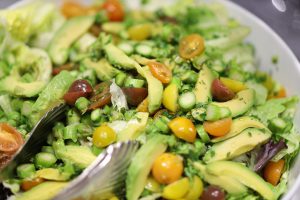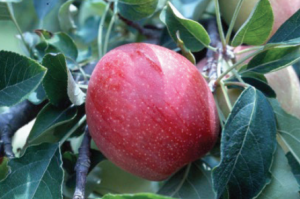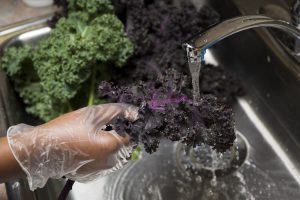
by Samantha Kennedy | Nov 10, 2020
It has often felt like time has dragged on in 2020, but despite all the challenges, time has continued to march on, and that means the holiday season is right around the corner. Thanksgiving is fast approaching; November 26th will be here before we know it. And while this year has been tough in many ways, we also have a lot for which to be thankful.
One of the ways we celebrate that gratitude is through a nice meal with friends and family. However, many of us have experienced financial difficulties over the last several months, which may put a damper on our traditional celebrations.
With that in mind, here are a few tips for saving money this Thanksgiving:

Keeping the sides simple and having guests contribute items to the meal are two ways to reduce the overall cost of a Thanksgiving meal. (Photo source: Tyler Jones, UF/IFAS)
Shop with a list. This is good advice for everyday shopping, too, but especially at the holidays, when there are just so many delicious seasonal goodies available and we might feel like splurging. Don’t get carried away, though! Stick to traditional favorites everyone enjoys and only get enough to feed the number of guests, not an army. And remember, if it’s not on the list, don’t buy it.
Shop early. Supermarkets often begin putting holiday food items on sale weeks before the main event. Planning ahead and purchasing ingredients early can save money in the long run. Also, think about purchasing canned and dry goods for next year’s festivities right after this Thanksgiving, as ingredient prices are reduced in order to sell them more quickly and make room for other items. Just remember to check the expiration/sell-by dates to make sure they do not expire before next year.
Choose one type of meat. Turkey is the traditional centerpiece to most American Thanksgiving meals, but it doesn’t have to be. Other popular meats include ham, lamb, roast, and prime rib. The key to saving money on the meat, however, is to choose just one. Meat is one of the most expensive items on a Thanksgiving menu, and, odds are, if there is an abundance of side dishes, there won’t be a need for as much meat.
Frozen over fresh. As for the turkey, go with a frozen store brand turkey. The savings could be significant over a name brand or fresh turkey. Just remember, frozen turkeys take time to thaw safely in the refrigerator. Plan for 24 hours of thawing time per five pounds of turkey. For example, a 15-pound turkey will take at least three days to thaw in the refrigerator. Remember to place the turkey in a pan to prevent juices from dripping onto other food in the refrigerator.
Make it a potluck. Ask guests to bring a dish to share with everyone else. This way, the expense is spread out over several people and everyone saves money. There are some really great free websites that allow people to sign up to bring certain items. Customizing the sign-up helps ensure that everything is accounted for and that there isn’t a pile of pumpkin pies but no side dishes.
For more information about holiday savings tips, contact Samantha Kennedy, Family and Consumer Sciences agent, at (850) 926-3931, or reach out to your local Extension office.
Additional Resources:
Five Steps to Seasonal Savings (UF/IFAS Extension)
Food Safety Tips for the Holiday Season (UF/IFAS Extension)
UF/IFAS is an Equal Opportunity Institution.

by Amy Mullins, PhD, RDN | Oct 9, 2020
By Matthew Poland and Amy Mullins, MS, RDN
Air fryers have become quite popular over the past few years, touted as a healthier alternative to deep-frying foods, while replicating the crispiness we all love. As a frequent user of an air fryer, I find times where I will catch myself talking family’s or friend’s ears off about how much I love my air fryer and how they should invest in one, too. Here are 3 reasons why an air fryer makes a great tool for any kitchen:
Health, Texture and Taste

Air fryers crisp food without the fat and calories of deep-frying.
Photo source: Matthew Poland
In my opinion, the number one reason to purchase an air fryer is the ability to make healthy alternatives to classically unhealthy foods. Fried foods consistently are given a thumbs-down from dietitians and other health professionals because the process of deep-frying foods exponentially increases their calorie content due to the nature of submerging foods in oils. However, a large reason why fried foods are so appealing is because of their texture. Deep-frying a food, specifically a breaded food, produces a crunchy exterior and a moist interior we’ve come to love. This is where an air fryer shines. Air fryers use circulating hot air to produce a very similar texture and taste to deep-fried foods, but can use up to 99% less oil (or even no oil), reducing calories by 70-80%, without sacrificing much in flavor (1).
Now, with anything, moderation is key, and this is not a suggestion to have chicken fingers and homemade French fries every night, just because they can be made healthier in an air fryer. However, this is a recommendation to curb cravings of greasy, high-calorie fast food meals by making them at home in an air fryer. In addition, the texture created by an air fryer is a perfect way to expand your dietary pallet, which leads me to my second reason for getting an air fryer: trying new foods.
New Food Experiences
With many kids, as well as adults, eating vegetables is not a desirable activity. They may be aware of the health benefits of vegetables, but when it comes to getting a vegetable past their nose and mouth, it can be a different story. A variety of preparation methods for vegetables exists, from raw to steaming to boiling. However, outside of roasting vegetables, many of these methods soften the texture of the food, which is often not appetizing to many people. Air frying then becomes the perfect method to produce crunchy, appealing vegetables that may just change some minds on whether or not an individual “likes vegetables.”
But the opportunities to try new foods are certainly not limited to just vegetables. From wings, to chicken kebabs, to eggplant parmesan, to air fried green beans, a wide variety of recipes exists for the air fryer. Often times, these recipes can be just as fast, easy, and even more delicious than using a conventional oven. This leads into my final point: the operation and cost of an air fryer.
Operation and Cost
Another benefit to air fryers is their ability to cook foods more quickly than in conventional ovens (or deep-fryers for that matter!). Air fryers reach cooking temperatures much faster than ovens can, but their small size can limit how much food can be cooked at one time, depending on the model. After a meal, cleanup is quick and easy, requiring only a wipe-down if little oil was used and cleaning maintenance is done regularly. Fortunately, air fryers also do not give off the same whole-house-consuming smells that deep-frying foods do.
Many of what could be considered “middle-of-the-line” models come with pre-programmed options for a variety of popular food choices. With the push of one button, it will let you know when the food is finished! Lastly: the cost of air fryers, which are actually quite reasonably priced. From simple, non-programmable fryers starting at around $40, to very snazzy two-basket, dual-zone fryers at around $150, there are various options to fit your exact needs.
In my experience, the air fryer has deservedly earned a spot on my ever-busy kitchen counter. Though they may not be as versatile as a conventional oven, or as quick as a microwave often, I believe they provide significant upsides that most people can find useful. Even if I haven’t convinced you to immediately run out and buy yourself an air fryer, I hope you have gained some insight into why you can’t stop hearing about them.
Matthew Poland is a Graduate Student in the Department of Food, Nutrition, and Exercise Sciences at Florida State University who is currently working on the Dietetic Internship to become a Registered Dietitian/Nutritionist (RDN).
References:
- Air-Frying: Is It As Healthy As You Think? (2020, August 19). Retrieved September 21, 2020, from https://health.clevelandclinic.org/air-frying-is-it-as-healthy-as-you-think/

by Melanie Taylor | Sep 22, 2020
As I write this article it is the first day of Fall. Many people are enjoying the cooler temperatures, school is in full swing, a few trees are changing colors and everyone is adjusting to shorter days. As Fall begins and we move forward through this unusual and stressful year, many of us need to focus on healthier lifestyles and eating well to be our best self.
Many of us know that fresh fruits and vegetables should be a staple in our daily diets. Apples ripen and are ready for harvest in September or October, making October National Apple Month. So be sure to eat a crisp apple on a nice Fall day. They are refreshing, and you can find ones that are sweet or tart for anyone’s taste buds. They are also a low-calorie food. One medium apple only has about 80 calories. Apples are also a great source of fiber, especially if you eat the peel, and a good source of vitamin C and potassium.

Apple Time
Photo Source: UF/IFAS
Selecting Apples: When selecting apples, they should be smooth skinned, crisp, juicy and a nice color for the variety. Handle apples gently to avoid bruising. Over 2,500 varieties of apples are grown in the United States, and around 100 varieties are grown commercially. Commercially grown apples will be what you see sold in most grocery stores.
Storing Apples: Apples will remain crisp and juicier longer if refrigerated. Store refrigerated apples in plastic bags with small air holes to maintain a high moisture level and delay withering. When storing apples in the refrigerator, they will last 6-8 weeks. Apples stored at room temperature typically last less than a week and lose their crispiness.
Preparing Apples: Simply rinse, refrigerate and enjoy. The best way to prepare your apples is to rinse them under cool tap water and dry with a paper towel. You may use a vegetable brush if you feel it needs more cleaning. Know that when apples arrive to the packing facility, they are washed to remove any dirt from the orchard, but you still need to rinse them. Apples can be cooked, canned, dried and frozen. Be sure to check out some healthy apple recipes from Michigan Apples, and The American Heart Association and preservation recipes from The University of Georgia.
Be sure to enjoy some delicious apples this October!
Sources:
American Heart Association https://www.heart.org
Michigan Applies https://www.michiganapples.com
So Easy to Preserve https://nchfp.uga.edu/
Food and Fitness from Harvest to Health http://missourifamilies.org/

by Dorothy C. Lee | May 11, 2020
Once known as star berries because of the pointy flower calyxes on top, blueberries have grown wild in North America for thousands of years. They were a staple among Native Americans, who dried and smoked the berries, and pounded them into venison to flavor the meat.

Berries such as blueberries are rich in vitamin, minerals, and antioxidants and can be delicious additions to yogurt, salads, and smoothies. (Photo source: UF/IFAS file photo)
Uses & Preparation
Wash blueberries just before using. Add to yogurt or cottage cheese or any fruit and mild cheese platter. For color and great taste, add to salads; or sweeten pancakes, cakes, and muffins.
Selection
Look for firm, dry, plump, smooth-skinned berries with a light grayish bloom. Ripe berries should be deep-purple blue to blue-black.
Storage
Cover and refrigerate fresh berries for up to 10 days. Blueberries are easily frozen for later use. Freeze unwashed blueberries in airtight, resealable plastic bags. If thawed, keep refrigerated and use within 3 days.
Blueberry Pancake Stacks
Vegetable Oil for cooking
1 cup milk
1 tablespoon vegetable oil
1 egg
1 cup all-purpose flour
1/2 teaspoons baking powder
1 teaspoon salt
1 cup fresh blueberries
Dash of nutmeg
In a mixing bowl, stir together the milk, oil, and egg. In a separate bowl, combine the flour, sugar, baking powder, salt and nutmeg. Add dry ingredients to the milk, and stir just until mixed (batter should be slightly lumpy). Gently fold in the berries. Spoon the batter onto a griddle or pan greased with vegetable oil and heated to medium-hot (dollops should be about the size of a silver dollar). Let the batter cook until the tops of the pancakes begin to bubble, then flip and cook until done. Stack and serve immediately with softened margarine and warm syrup. Makes about eighteen 2 1/2″ pancakes.
Blueberry Syrup
Combine 1 pint of blueberries and 1 cup of maple syrup in a saucepan. Heat to boiling, then lower the heat and simmer until most of the fruit has burst. Remove from heat and use a fork to mash the berries. The syrup will thicken as it cools. Store in the refrigerator for up to 2 days.
Nutrition Information: Good source of vitamin C. High in fiber. Low in calories.
Available Fresh: April – June
To learn about fresh Florida strawberries, please read our fact sheet: Panhandle Produce Pointers – Blueberries.
.For more delicious produce preparation tips, please visit: http://www.panhandleproducepointers.com.
UF/IFAS Extension is an Equal Opportunity Institution.

by Dorothy C. Lee | Mar 3, 2020
Spring showers not only bring flowers, but beautiful fresh produce from the garden.
March in National Nutrition Month. Celebrate with nutritious delicious GREENS.

Be sure to carefully wash greens before preparing to ensure a safe and delicious product. (Photo source: Tyler Jones, UF/IFAS)
The dark leafy vegetable we refer to as “greens” range from earthy to peppery in flavor. Collard greens, mustard greens, turnip greens, and kale are often grouped together because of their texture, pronounced flavor, and general uses. They actually come from several vegetable families. In general, these tart greens are cooked before eating. The season for some varieties peak November through March.
Choose leafy greens with fresh full leaves. Avoid greens that are brown, yellow spotted, wilted, or have slimy leaves. Wash greens before use. Cut stems from leafy greens before cooking. Sauté collard greens with garlic, onions, and tomatoes a little bit of olive oil. Simmer greens in low-sodium chicken broth until greens are wilted and tender. Store greens in a plastic bag in the refrigerator for two to five days.
NUTRITION TIPS: A 1/4 cup of cooked greens is about the size of one cupped handful.
Beans and Greens
1 can white kidney beans or cannellini beans rinsed and drained
1 tablespoon olive oil
1/2 cup diced onion
2 cloves garlic, minced
2 pounds fresh kale, stemmed and chopped into large pieces
Salt and pepper to taste
Sauté onion and garlic in olive oil. Add greens to the skillet. Sprinkle with 2 tablespoon of water. Cook, tossing often, until greens are bright green and slightly wilted. Remove from heat. Drain and heat beans and add to green mixture. Toss mixture, season and serve. Serves four; 1 cup serving
Savory Greens
3 cups water
1/4 pound skinless turkey breast
1/2 cup chopped onions
2 cloves garlic, crushed
1/4 teaspoon cayenne pepper
1/4 teaspoon ground cloves
1/2 teaspoon dried thyme
1 green ground ginger
2 pounds mixed greens (collards, turnips, mustard, and kale)
Place all ingredients except greens into large pot and bring to a boil. Wash greens and remove stems. Chop greens into small pieces and add to stock. Cook 20 to 30 minutes until tender. Serves six; 1 cup serving
NUTRITION INFORMATION: Cooked greens are excellent sources of Vitamins A, C, K, and Calcium.
AVAILABLE FRESH: March – June & October – December
To learn about fresh Florida greens, please read our fact sheet: Panhandle Produce Pointers – Greens.
For more delicious produce preparation tips, please visit: http://www.panhandleproducepointers.com.

by Angela Hinkle | Jan 24, 2020
My favorite time – snack time! For February, National Snack Food Month, let’s celebrate these tasty morsels for a whole month.
Go Beyond the Snack Aisle
Snacks often have a bad reputation, at least in terms of health. It’s true that snack food aisles are often filled with high fat, high calorie, high sodium, and high sugar choices. But snacks can be great sources of fiber, vitamins, minerals, proteins, and healthier fats and carbohydrates. You may just have to wander to other parts of the store next time you shop.
Think Mini Meal
When you snack, think of it as a mini meal. Though you could plan tomorrow’s dinner to be a plate of snack cakes with a side of potato chips, hopefully you come up with something more satisfying than that – both in taste and nutrition. Additionally, when we snack on healthier foods in between meals, it gives our bodies the sustainable energy it needs to make it to that next meal.

Snacks – Fun, Tasty, and Healthy
Photo Source: Angela Hinkle
Snack MyPlate
Try snacking from all five food groups this month.
- Whole grains – popcorn, granola, whole grain crackers
- Fruits – apples, bananas, oranges, raisins
- Veggies – pea pods, cucumber slices, carrots
- Dairy – string cheese, yogurt cups, individual shelf stable cartons of milk
- Protein – hard-boiled eggs, mixed nuts, healthy beef jerky
Make Homemade Mixed-Up Food Group Snacks
- Whole grain pita or multi-colored pepper slices dipped in guacamole or hummus
- Apple slices or carrots with peanut butter dip
- Cherry tomatoes with mozzarella and basil
- Fruit smoothies or protein shakes
- Yogurt with granola and mixed berries
- Banana Sushi – smear a whole wheat tortilla with peanut butter, put a banana in the middle, roll it up, then cut it into “sushi” slices
For more great snacking ideas, check out 10 Snack Tips for Parents, MyPlate Snack Tips for Kids, and 25 Healthy Snacks for Kids
Delicious, healthy, on-the-go snacks. Be creative and keep it healthy this February – National Snack Food month.












